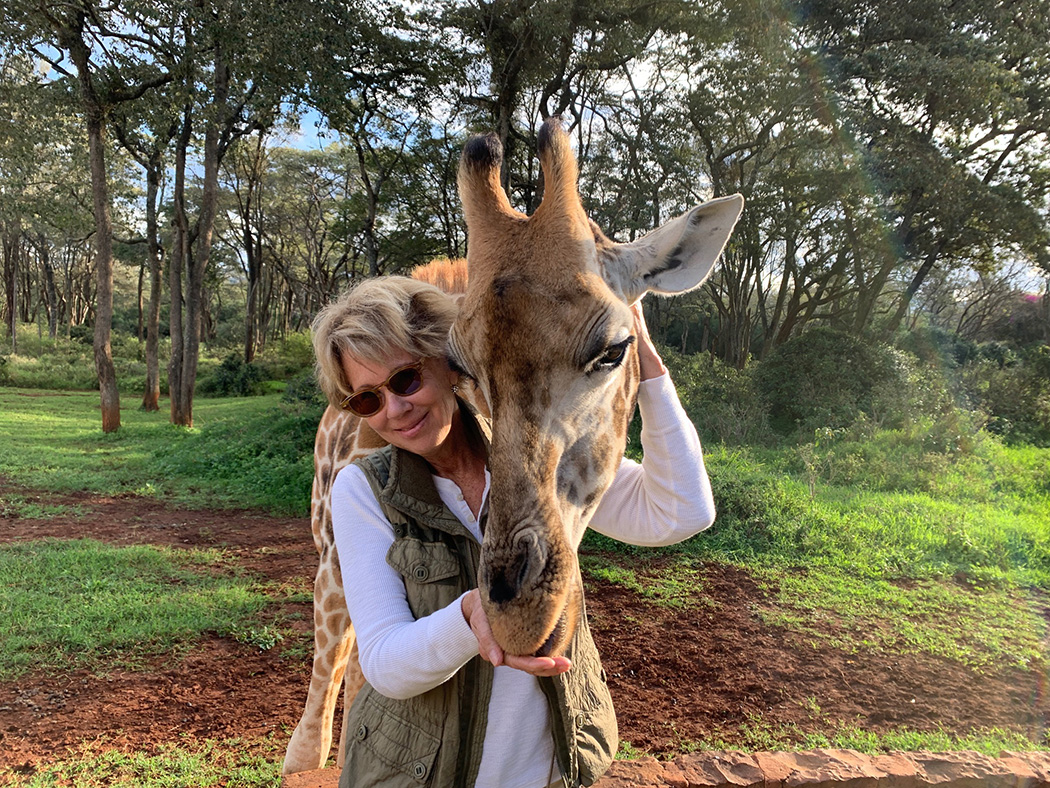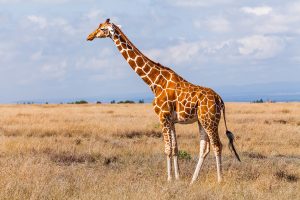 After breaking the glass and grass ceiling, Susan Reno Myers is now standing tall for giraffes. Once an investment banker for J.P. Morgan on Wall Street and in Europe, she was featured in the Wall Street Journal in 2007 for being one of the country’s few female high school football coaches when she managed the wide receivers at Prince of Peace Catholic School in Plano. As the founder and CEO of the nonprofit Save Giraffes Now, Myers travels to Africa frequently. She planned to oversee a fundraiser April 20 at the Dallas Country Club. Among her talking points? Donating $90 will free a giraffe from a snare. After attending Wellesley College, she received a Master of Business Administration from Harvard University. Myers, who has lived in a Preston Hollow home decorated with maps of the world and animal patterns since 2014, has one daughter, Christina.
After breaking the glass and grass ceiling, Susan Reno Myers is now standing tall for giraffes. Once an investment banker for J.P. Morgan on Wall Street and in Europe, she was featured in the Wall Street Journal in 2007 for being one of the country’s few female high school football coaches when she managed the wide receivers at Prince of Peace Catholic School in Plano. As the founder and CEO of the nonprofit Save Giraffes Now, Myers travels to Africa frequently. She planned to oversee a fundraiser April 20 at the Dallas Country Club. Among her talking points? Donating $90 will free a giraffe from a snare. After attending Wellesley College, she received a Master of Business Administration from Harvard University. Myers, who has lived in a Preston Hollow home decorated with maps of the world and animal patterns since 2014, has one daughter, Christina.
Why did you choose to coach football?
I started watching football to have something to talk about, and I got fascinated with the game.
How did you become interested in giraffes?
I knew I wanted my third career to be animal related, but I wasn’t sure what. I talked about becoming a vet tech because we have four dogs. We’ve had as many as six, generally rescues. I was on the board of the Dallas Zoo, and I learned how wildlife conservation works. I didn’t know what an ungulate was. I decided to have an impact in the field. I wanted to set up my own charity and focus on one species.
Why giraffes?
Giraffes are the nice guys of the animal world. They’re unassuming. They’re generally sweet. They don’t eat other animals. I support the Cheetah Conservation Fund, too, so I’m not against predators. Giraffes are ignored. They are undergoing a silent extinction. There are four times as many elephants in Africa as giraffes. The elephants and the rhinos get all the attention because the violence against them is brutal. When I was younger, I played a game. My favorite animal came out as a giraffe. I wrote, “They are elegant, comical and misunderstood.” They’re the sweetest beings you can imagine.
DID YOU KNOW?
Thirty percent of the giraffe population declined in the last three decades.
Fifty percent or more of giraffe infants won’t survive to adulthood.
How do you go about raising money for them?
We’re looking at a two-pronged approach. One is to find higher net-worth people, but I have a strong philosophy to not cannibalize people who are already donating to save other animals. The wildlife fundraising world is a bit of a jungle. I’m trying to raise new funds and find new people who want to contribute to wildlife conservation. The second approach is through social media.
How long have you been doing this?
The concept is only a year old. I’ve been on the road a lot. We have projects in 10 countries in Africa. There are four giraffe sub-species, and our projects fund each of them.
What kind of results have you gotten so far?
We started a website, and we’re beginning our fundraising campaign.
How often do you go to Africa?

Ol Pejeta Conservancy, Kenya
Every other month. I was focused a lot on Kenya, but now we’re moving into Botswana, Zimbabwe and more. When you go, you get back to your roots. You’re away from the iPad, iPhone, computer and email, and you feel like you are part of something bigger.
What are your favorite memories of Africa?
I was blessed to go to Kenya in 1972. When you were on a safari then, the animals had never seen a human before. Now the animals are used to seeing people. They seem to say, “OK, it’s the two o’clock tourists. They’re here.”
What are the biggest threats to giraffes?
It depends what area they are in. Human encroachment and human or wildlife conflict are problems because giraffes sometimes destroy crops. They like to eat mangoes. They run into electric wires in certain countries. There is some poaching in the war areas for bushmeat. People eat giraffe. There’s also a loss of habitat. They can’t breathe. Some are isolated. Their migration paths and eating patterns are disrupted. In northern Kenya, they’ve actually put a tunnel under the highway for the animals. I think it was originally for the elephants, but it’s tall enough for giraffes. The animals can cross over to eat and have new spouses.
How can people help your cause?
Spread the word that giraffes need help, attention and love. Contribute to us. We signed a memorandum of understanding with the San Diego Zoo Global. They have projects in various parts of Africa, so we’re helping support those.
What do you like about living in Preston Hollow?
It’s gorgeous. I love being able to walk and bike on the roads here. I feel like I’m on an English country lane. People are kind and interesting.
What’s the best advice you’ve ever received?
Do what you love, and do it with good people.
What advice would you give to your younger self?
I was timid for a long time, particularly in terms of speaking up for my own interests. My dad had raised me with the idea that you’re grateful for a job. You do what your boss says, and you never question it. You never ask for a raise. You just say, “Thank you.” I’ve always been early as a female leader. There were not many women on Wall Street when I worked there. When I coached football, there were no women. You got to know when to break china and when to be slow and steady to win the race.






